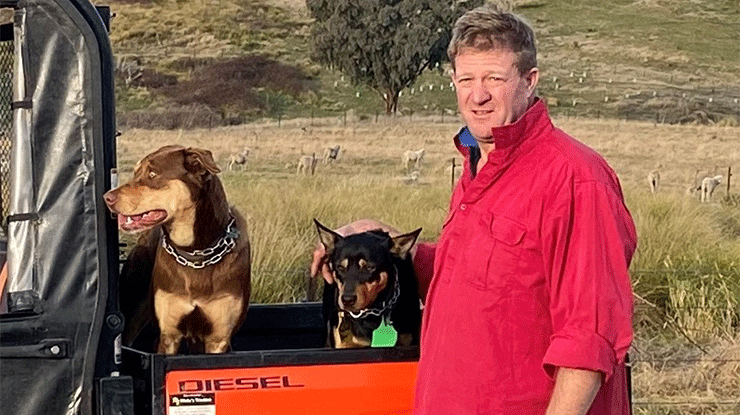Soil information is gold
20 August 2021
 Murray Gregory, Bigga, NSW
Murray Gregory, Bigga, NSW
Murray Gregory is always on the lookout for ‘golden nuggets of knowledge’ and has found a goldmine at the Heathy Soils Group run by the Tablelands Farming Systems.
Murray and his wife Katrina run a 900ha grazing property carrying Merino wethers and Angus cattle at Bigga, an hour north west of Crookwell, NSW.
Their 900ha ha property receives an annual rainfall of 830mm and has phalaris and sub clover based pastures on hilly to mildly undulating arable slopes.
“We left Sydney three years ago where I had worked as a builder – I was city born and bred and had no background in farming apart from childhood holidays on farms,” Murray said.
“Buying a farm was a lifelong dream but I was very conscious that I need to learn a lot so I am always looking for information.
“Since we moved to the farm we’ve joined the local Landcare and grazing groups and I have done a Prograze course, a Local Land Services soil workshop and an RCS pasture clinic.
“I joined the Tablelands Farming Systems group coordinated by Pip Frost 12 months ago because I was looking for more information on soils and farm management.”
Valuable soil group workshops
The Tableland Farming Systems group recently ran a Meat & Livestock Australia (MLA) funded Healthy Soils Group facilitated by consultant Jim Virgona of Garminus Consulting who organised a number of workshops covering soil issues.
The first workshop was held at Gunning and was based on managing and measuring ground cover.
The follow up workshops covered interpreting soil tests, understanding physical and chemical characteristics – such as pH - in both top soil and changes down the soil profile.
One workshop featured Charles Sturt University soil scientist Dr Jason Condon on understanding the textures and characteristics of different soil types in the top 10 cm and 10-20cm zone.
Another workshop featured a soil pit, giving participants a chance to see and understand changes in the soil profile and chemical characteristics of different soils and subsoils and how they affected plant growth.
“I really had no appreciation of soil when I started farming and I came away from these workshops with little golden nuggets of knowledge,” Murray said.
“The workshops gave me an understanding of what caused the different soil layers and the changes in the soil’s physical, chemical and biological characteristics in different layers, and how they affected root growth and penetration.
“I learnt a lot from the opportunity to look at soil pits, use soil ribboning to understand the clay content and how it changed down the soil profile. I came away with techniques I could apply at home.
Techniques to apply at home
“Before the workshop I had read about deep ripping, but after listening to the speakers and learning about the soil characteristics I now understand what is in our soil profile.
It’s now very clear that deep ripping isn’t suitable with our soil type and would risk damaging our soil structure,” Murray said.
“It makes you appreciate how fragile top soil is and how important it is to know what is under the top soil.
“When we started farming we just put out 350kg/ha of single super but we didn’t see a great response – albeit in the middle of the drought.
“Now we are regularly using soil tests to make informed decisions about what fertiliser to apply.
“This includes rate of phosphorous, the use of lime and more recently some foliar fertiliser applications,” Murray said.
“We need to work with the top soil we have so I am now looking at making sure we manage our grazing system to maintain groundcover at all times.
“Protecting our top soil has meant making changes to our grazing management.
“We are subdividing paddocks into smaller areas so we can increase our use of rotational grazing and have greater control on how we manage our pastures to increase our pasture production and manage pasture cover.
“I’ve also recently started using the Healthy Soils hub resources on the MLA website as a follow up to the recent workshops – it’s another source of ‘golden nuggets of knowledge,” Murray said.


